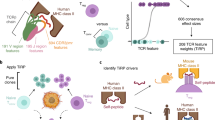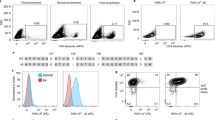Abstract
The class I molecules of the major histocompatibility complex (H–2 in mouse, HLA in man) are membrane proteins composed of a polymorphic heavy chain associated with β-2-mieroglobulin. Recent studies suggest that class I molecules present peptides derived from processed antigens to the receptor of cytolytic T cells1,2. In particular, in the H–2d haplotype, synthetic HLA peptides can be recognized on Kd-bearing target cells by Kd-restricted cytolytic T cells specific for HLA (ref.2). Here we analyse the specificity of presentation of two HLA peptides by a set of chimaeric Kd/Dd molecules3 to four different cytolytic T-cell clones. We identify two distinct regions within the second external (αa2) domain of Kd that contribute to its specificity as a restriction element. Our results indicate that the binding of an immunogenic peptide by a class I molecule is not always sufficient for its recognition by the T-cell antigen receptor. This suggests that the major histocompatibility complex restriction element either interacts with the T-cell antigen receptor or induces the recognized conformation of the peptide.
This is a preview of subscription content, access via your institution
Access options
Subscribe to this journal
Receive 51 print issues and online access
$199.00 per year
only $3.90 per issue
Buy this article
- Purchase on Springer Link
- Instant access to full article PDF
Prices may be subject to local taxes which are calculated during checkout
Similar content being viewed by others
References
1. Townsend, A. R. M. et al. Cell 44, 959-968 (1986). 2. Maryanski, J. L., Pala, P., Corradin, G., Jordan, B. R. & Cerottini, J.-C. Nature 324, 578-579 (1986). 3. Abastado, J. P., Darche, S., Godeau, F., Cami, B. & Kourilsky, P. Proc. natn. Acad. Sci. U.S.A. 84, 6496-6500 (1987). 4. Maryanski, J. L., Accolla, R. S. & Jordan, B. /. Immun. 136, 4340-4347 (1986). 5. Burgert, H.-G., Maryanski, J. L. & Kvist, S. Proc. natn. Acad. Sci. U.S.A.S4,1356-1360 (1987). 6. Maryanski, J. L. et al. Proc. 18th International Leukocyte Culture Conf. (in the press). 7. Abastado, J. P. et al. J. exp. Med. 166, 327-340 (1987). 8. Scholler, J., Shimonkevitz, R., MacDonald, H. R. & Kvist, S. J. exp. Med. 164, 1823-1834 (1986). 9. Sherman, L. A. Nature 297, 511-513 (1982). 10. Cowan, E. P., Jordan, B. R. & Coligan, J. E. /. Immun. 135, 2835-2841 (1985). 11. Bjorkman, P. J. et al. Nature 329, 506-512 (1987). 12. Bjorkman, P. J. et al. Nature 329, 512-518 (1987). 13. Heber-Katz, E. et al. J. exp. Med. 155, 1086-1099 (1982). 14. Claverie, J. M. & Kourilsky, P. Ann. Immun. (Inst. Pasteur] 137D, 425-442 (1986). 15. Babbit, B. P., Alien, P. M., Matsueda, G., Haber, E. & Unanue, E. R. Nature 317, 359-361 (1985). 16. Buus, S. et al. Proc. natn. Acad. Sci. U.S.A. 83, 3968-3971 (1986). 17. Buus, S., Sette, A., Colon, S. M., Jenis, D. M. & Grey, H. M. Cell 47, 1071-1077 (1986). 18. Buus, S., Sette, A., Colon, S. M., Miles, C. & Grey, H. M. Science 235, 1353-1358 (1987). 19. Guillet, J.-G., Lai, M. Z., Briner, T. J., Smith, J. A. & Gefter, M. L. Nature 324, 260-262 (1986). 20. Guillet, J. G. et al. Science 235, 865-870 (1987). 21. Colbere-Garapin, F., Chousterman, S., Horodniceanu, F., Kourilsky, P. & Garapin, A. C. Proc. natn. Acad. Sci. U.S.A. 76, 3755-3759 (1979). 22. Greenstein, J. L., Malissen, B. & Burakoff, S. J. J. exp. Med. 162, 369-374 (1985). 23. Cochet, M. et al. Immunogenetics 24, 267-274 (1986). 24. Pala, P. et al. J. Immun. (in the press). 25. Maryanski, J. L., Pala, P., Cerottini, J.-C. & Corradin, G. / exp. Med. (in the press).
Author information
Authors and Affiliations
Rights and permissions
About this article
Cite this article
Maryanski, J., Abastado, JP. & Kourilsky, P. Specificity of peptide presentation by a set of hybrid mouse class I MHC molecules. Nature 330, 660–662 (1987). https://doi.org/10.1038/330660a0
Received:
Accepted:
Issue Date:
DOI: https://doi.org/10.1038/330660a0
This article is cited by
Comments
By submitting a comment you agree to abide by our Terms and Community Guidelines. If you find something abusive or that does not comply with our terms or guidelines please flag it as inappropriate.



